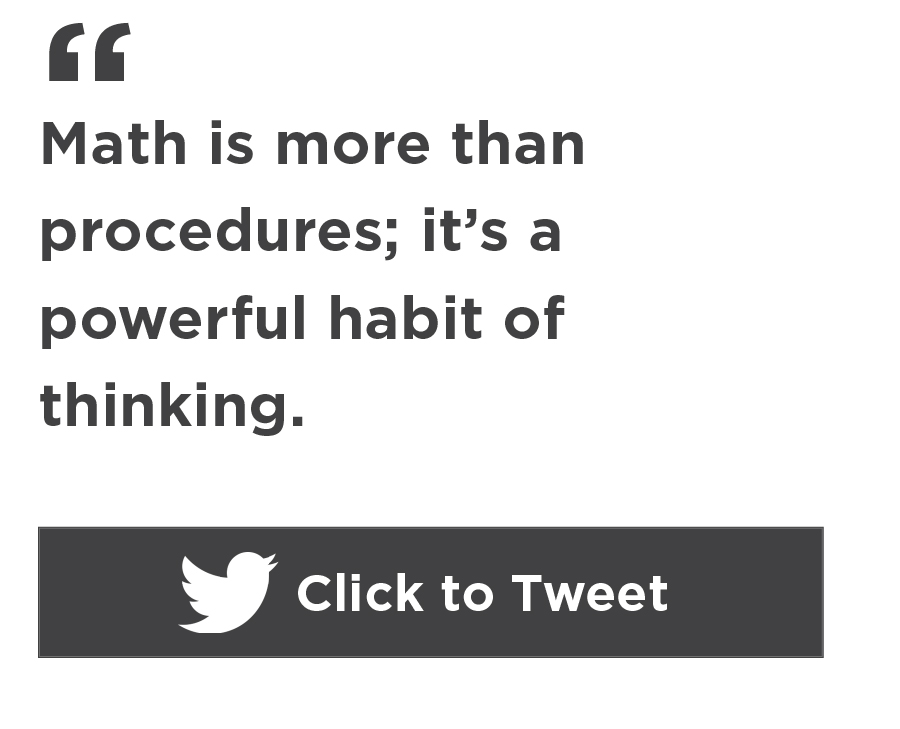Have you ever thought about what it really means to learn mathematics? Is it about computing things quickly? Making connections between ideas? Scoring high on tests? What about being able to use mathematics in the world around you? As someone who taught mathematics at the high school and college levels for twenty years, I have pondered these questions for quite some time.
For many, learning mathematics leads to perceiving the subject as a collection of procedures that are disconnected from any big picture. It’s much like filling a box with puzzle pieces, yet never building the puzzle. Indeed, there’s a reason the refrain “Ours is not to reason why, just invert and multiply” is as well-known as it is.
I refer to this view on procedures as an instructional focus on ways of doing. Now, don’t get me wrong. Learning mathematics involves doing things. There are procedures to be learned. Those procedures, though, are tools to do mathematical things, not the end goal. The end goal is much more than that.
Piecing together the puzzle
Mathematical procedures are not magical or mysterious. Think about this: Mathematics is a discipline grounded in logic. One could argue it is the discipline that, at its core, makes the most sense. Yet students routinely leave class baffled and remark how it doesn’t make any sense. How can this be? It’s simple, really. We chop the big picture into tiny pieces, teach each piece separately, and then ask students to store those pieces in some sort of cluttered, mental box. Such a strategy can only go so far.
If ways of doing are part of learning mathematics, but not the overall goal, what else is involved? Let’s go back to the puzzle analogy. Individual pieces fit together to create a picture that is larger than any one element. The picture tells a story, and each part fits into that story in some thoughtful way; there are no lone pieces. Similarly, we need to have ways of thinking about mathematical notions to weave ways of doing together in some thoughtful (and logical) way. For example, I might focus on ways of thinking about division, such as how division allows me to compare two quantities multiplicatively or determine a group size or see how many groups I can make. When someone asks me to compare two quantities, I may think about how division or subtraction could do the job, and how each would provide different insights. I might need a procedure to help, but I also might not.
Learning mathematics—really learning it—also requires developing what I refer to as powerful habits of thinking. How could we do this? We can promote beliefs about mathematics that are productive using VAMS taxonomy (see page 247). We can model how mathematicians solve problems. We can also intentionally build students’ mathematical identities (especially as a way to refute stereotypes that may be holding them down) while we develop positive and productive mathematical practices.
To me, then, mathematics learning, at a minimum, means learning:
- Ways of thinking that are empowered by…
- Habits of thinking, along with an ability to make sense of and use some…
- Ways of doing to do something bigger with mathematics.
How it all comes together: An example
Let’s turn to a specific example: proportional relationships. Why? Well, it turns out that there is quite a bit of confusion, even among experts, as to exactly what they are about. The confusion around proportionality is unfortunate, really, as such relationships are of high importance in the mathematics curriculum and serve to connect the work in elementary grades to the work in high school.
I’ve seen plenty of ways of doing associated with mathematics instruction on proportionality, yet I’ve also noticed a lack of ways of thinking about them. And, as noted above, ways of doing without ways of thinking leads to trouble.
Try this: Force yourself to describe what it really means to say something is out of proportion. Write something down. Does your single response extend to each of these situations?
Did habits of thinking, such as reflection, precision, and clear communication, lead to an “aha” about a potential gap in your way of thinking? Is it possible that your own ways of doing are floating around, disconnected from a powerful way of thinking? Can you imagine a powerful way of thinking about proportional relationships that connects what may otherwise be considered disconnected?
Over the past few years James Tanton, with the Global Math Project; April Strom, with Chandler-Gilbert Community College in Arizona; Kyle Pearce, with the Greater Essex County District School Board in Ontario, Canada; and I have pondered the disconnects and confusions around proportional relationships. We’ve had many discussions and debates, both with ourselves and with others. Read our paper (“Proportional relationships decluttered—at last!”) to learn more about proportionality and reflect on how you might teach it differently. We hope it can help you build a strong way of thinking about proportional relationships and that it might motivate further attention to the importance of ways of thinking and habits of thinking.










